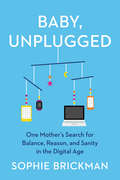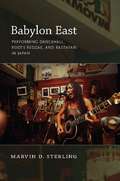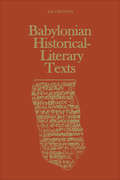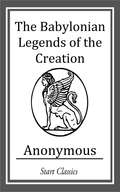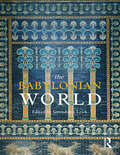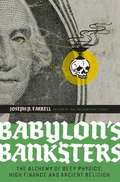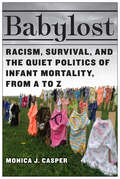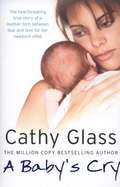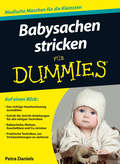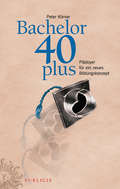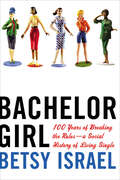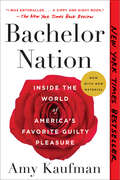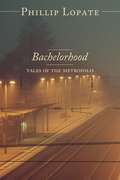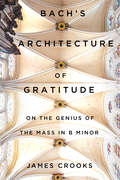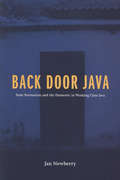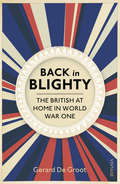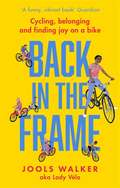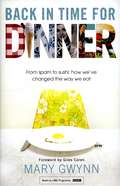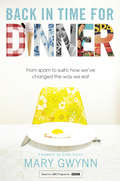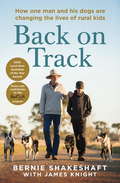- Table View
- List View
Baby, Unplugged: One Mother's Search for Balance, Reason, and Sanity in the Digital Age
by Sophie BrickmanA charming, meticulously researched, and illuminating look at how technology infiltrates every aspect of raising children today, filled with helpful advice parents can use to best navigate the digital landscape, and ultimately learn to trust their own judgment.There’s an app or device for nearly every aspect of parenting today: monitoring your baby; entertaining or educating your toddler; connecting with other new parents for tips, tricks, and community—virtually every aspect of daily life. But it isn’t a parenting paradise; the truth is much more complicated. The mother of two young daughters, journalist Sophie Brickman wondered what living in a tech-saturated world was doing to her and her children. She turned to experts, academics, doctors, and innovators for advice and insight. Baby, Unplugged brings together Brickman’s in-depth research with her own candid (sometimes hilarious) personal experience to help parents sort through the wide and often confusing tech offerings available today and to sort out what’s helpful and what’s not. Filled with relatable and entertaining stories as well as practical takeaways, Baby, Unplugged is destined to become a touchstone for parents today, giving them the permission to forge their own path through the morass of technological options, to restore their faith in themselves, and to help them raise good, social, and engaged people in the modern world.
Babylon East: Performing, Dancehall, Roots Reggae and Rastafari in Japan
by Marvin D. SterlingAn important center of dancehall reggae performance, sound clashes are contests between rival sound systems: groups of emcees, tune selectors, and sound engineers. In World Clash 1999, held in Brooklyn, Mighty Crown, a Japanese sound system and the only non-Jamaican competitor, stunned the international dancehall community by winning the event. In 2002, the Japanese dancer Junko Kudo became the first non-Jamaican to win Jamaica's National Dancehall Queen Contest. High-profile victories such as these affirmed and invigorated Japan's enthusiasm for dancehall reggae. In Babylon East, the anthropologist Marvin D. Sterling traces the history of the Japanese embrace of dancehall reggae and other elements of Jamaican culture, including Rastafari, roots reggae, and dub music. Sterling provides a nuanced ethnographic analysis of the ways that many Japanese involved in reggae as musicians and dancers, and those deeply engaged with Rastafari as a spiritual practice, seek to reimagine their lives through Jamaican culture. He considers Japanese performances and representations of Jamaican culture in clubs, competitions, and festivals; on websites; and in song lyrics, music videos, reggae magazines, travel writing, and fiction. He illuminates issues of race, ethnicity, gender, sexuality, and class as he discusses topics ranging from the cultural capital that Japanese dancehall artists amass by immersing themselves in dancehall culture in Jamaica, New York, and England, to the use of Rastafari as a means of critiquing class difference, consumerism, and the colonial pasts of the West and Japan. Encompassing the reactions of Jamaica's artists to Japanese appropriations of Jamaican culture, as well as the relative positions of Jamaica and Japan in the world economy, Babylon East is a rare ethnographic account of Afro-Asian cultural exchange and global discourses of blackness beyond the African diaspora.
Babylonian Historical-Literary Texts
by Albert Kirk GraysonEarly Assyriologists were lured to Babylonian studies by the light which cuneiform text shed on ancient history and the Bible, and for later scholars this is still the attraction. The Age of Discovery is not past, and one can still read literature that has been unseen by the eyes of man for millennia. There are myriads of tablets lying in the ancient ruins of Iraq, Iran, Syria, and Turkey, waiting for the excavator's spade; in museums there are quantities of inscriptions that have not yet been made public.
The Babylonian Legends of the Creatio
by AnonymousThe Babylonian Legends of the Creation and the Fight Between Bel and the Dragon as Told by Assyrian Tablets From Nineveh contianing the following: "The Discovery of the Tablets" "Publication of the Creation Tablets" "The Object of the Babylonian Legend of the Creation" "Variant Forms of the Babylonian Legend of the Creation" "The "Bilingual" Version of the Creation Legend" "The Legend of the Creation According to Berosus and Demascius" "The Seven Tablets of Creation - Description of Their Contents" "The Seven Tablets of Creation - 1st, 2nd, 3rd, 4th, 5th, 6th, 7th" "Epilogue"
Babylonian Magic and Sorcery: Being "The Prayers of the Lifting of the Hand"
by Leonard W. KingThis classic work is a treasury of esoteric writing concerning the prayers and rituals to ancient deities from the dawn of Western civilization.In this work first published in 1896, King presents the cuneiform text of a group of sixty clay tablets inscribed with prayers and religious compositions of a devotional and magical character. These tablets were created by the scribes of Ashurbanipal, King of Assyria, between 669–625 B.C., and are currently part of the Kuyunjik collection in the British Museum. King’s illustrations feature a transliteration of each tablet with an English translation of well-preserved passages.King includes a Babylonian-English glossary, a list of proper names and numerals with their corresponding cuneiform inscriptions, and a list of words and word portions of uncertain translation.“The texts and translations are accurately presented and definitive. King’s notes are concise, to the point, and easy to follow. But this is a highly technical book, designed for the professional, whether that professional be Assyriologist, paleographer, or magician. What, then, is its value to the non-professional reader? The answer is clear. Babylonian Magic and Sorcery offers us the means to gain an insight into the magico-religious concepts of the Semitic nations. And it is these concepts, and the magic based upon them, that underlie the worldview of the Western esoteric tradition, for that tradition is essentially Judaeo-Christian—it does not, save indirectly, derive from ancient Egypt.” —from the Foreword by R. A. Gilbert
The Babylonian World (Routledge Worlds)
by Gwendolyn LeickThe Babylonian World presents an extensive, up-to-date and lavishly illustrated history of the ancient state Babylonia and its 'holy city', Babylon. Historicized by the New Testament as a centre of decadence and corruption, Babylon and its surrounding region was in fact a rich and complex civilization, responsible for the invention of the dictionary and laying the foundations of modern science. This book explores all key aspects of the development of this ancient culture, including the ecology of the region and its famously productive agriculture, its political and economic standing, its religious practices, and the achievements of its intelligentsia. Comprehensive and accessible, this book will be an indispensable resource for anyone studying the period.
The Babylonian World (Routledge Worlds)
by Gwendolyn LeickThe Babylonian World presents an extensive, up-to-date and lavishly illustrated history of the ancient state Babylonia and its 'holy city', Babylon.Historicized by the New Testament as a centre of decadence and corruption, Babylon and its surrounding region was in fact a rich and complex civilization, responsible for the invention of the dictionary and laying the foundations of modern science. This book explores all key aspects of the development of this ancient culture, including the ecology of the region and its famously productive agriculture, its political and economic standing, its religious practices, and the achievements of its intelligentsia.Comprehensive and accessible, this book will be an indispensable resource for anyone studying the period.
Babylon's Banksters
by Joseph P. FarrellIn this latest installment of his remarkable series of books of alternative science and history, Joseph P. Farrell outlines the consistent pattern and strategy of bankers in ancient and modern times, and their desire to suppress the public development of alternative physics and energy technologies, usurp the money creating and issuing power of the state, and substitute a facsimile of money-as-debt. Here, Farrell peels back the layers of deception to reveal the possible deep physics that the "banksters" have used to aid them in their financial policies.Feral House also published Farrell's Philosopher's Stone: Alchemy and the Secret Research for Exotic Matter.
Babylost: Racism, Survival, and the Quiet Politics of Infant Mortality, from A to Z
by Monica J. CasperThe U.S. infant mortality rate is among the highest in the industrialized world, and Black babies are far more likely than white babies to die in their first year of life. Maternal mortality rates are also very high. Though the infant mortality rate overall has improved over the past century with public health interventions, racial disparities have not. Racism, poverty, lack of access to health care, and other causes of death have been identified, but not yet adequately addressed. The tragedy is twofold: it is undoubtedly tragic that babies die in their first year of life, and it is both tragic and unacceptable that most of these deaths are preventable. Despite the urgency of the problem, there has been little public discussion of infant loss. The question this book takes up is not why babies die; we already have many answers to this question. It is, rather, who cares that babies, mostly but not only Black and Native American babies, are dying before their first birthdays? More importantly, what are we willing to do about it? This book tracks social and cultural dimensions of infant death through 58 alphabetical entries, from Absence to ZIP Code. It centers women’s loss and grief, while also drawing attention to dimensions of infant death not often examined. It is simultaneously a sociological study of infant death, an archive of loss and grief, and a clarion call for social change.
A Baby's Cry
by Cathy GlassWhen Cathy is first asked to foster one-day old Harrison her only concern is if she will remember how to look after a baby. But upon collecting Harrison from the hospital, Cathy realises she has more to worry than she thought when she discovers that his background is shrouded in secrecy. She isn't told why Harrison is in foster care and his social worker says only a few are aware of his very existence, and if his whereabouts became known his life, and that of his parents, could be in danger. Cathy tries to put her worries aside as she looks after Harrison, a beautiful baby, who is alert and engaging. Cathy and her children quickly bond with Harrison although they know that, inevitably, he will eventually be adopted. But when a woman Cathy doesn't know starts appearing in the street outside her house acting suspiciously, Cathy fears for her own family's safety and demands some answers from Harrison's social worker. The social worker tells Cathy a little but what she says is very disturbing. How is this woman connected to Harrison and can she answer the questions that will affect Harrison's whole life?
Babysachen stricken für Dummies (Für Dummies)
by Petra DanielsGestrickte Babysachen sind nicht nur modisch aktuell, sondern auch schnell fertig gestellt. Außerdem bieten Technik und Materialien viele Vorteile für das Baby. Spezielle Strickgarne und Techniken ermöglichen hautfreundliche, weiche und pflegeleichte Projekte. Das Buch gibt Müttern, Vätern, Omas und Opas, Tanten und Onkeln, Paten und allen, die gern stricken, kreative Anregungen, um für das Baby ein individuelles und persönliches Stück zu fertigen: von Babysöckchen und -mützen über Wickel- und Kapuzenjäckchen bis zu Schmusetuch und Kuschelhase.
Babywatching
by Desmond MorrisDesmond Morris combines his skills as a zoologist and manwatcher to take a close look at the most remarkable life-form ever to draw breath on this planet - the human baby. In a revealing portrait of life from the baby's point of view, Desmond Morris answers the questions that parents ask: How important is a mother to her baby? How well can babies hear, smell and taste? Why do babies cry? And what makes a baby smile? Do babies dream? Babywatching is a classic to rank alongside Desmond Morris's world bestsellers, The Naked Ape and Manwatching.
Bachelor 40plus: Pladoyer fur ein neues Bildungskonzept
by Peter KornerNahezu unser gesamtes Bildungsbudget wird in die ersten Lebensphasen investiert, obwohl die hier vermittelten Fähigkeiten und das fachliche Wissen nach zehn oder 20 Jahren überholt sind. Die deutsche Wirtschaft braucht Menschen über 40, die ausschlieà liche Konzentration auf die Aus- und Weiterbildung junger Menschen ist ein Indiz gesellschaftspolitischen Versagens. Wir benötigen ein bedarfsorientiertes Bildungssystem mit einem neuen, quartären Sektor, der sich an ältere Teilnehmer richtet, die bereits 15 bis 20 Jahre Berufstätigkeit hinter sich und mindestens noch eine solche Spanne vor sich haben. Der neue Sektor erfüllt aber noch weitere Zwecke. Die längeren Lebensarbeitszeiten mit vielfältigen Neuorientierungen und die geringere Anzahl klassischer Karrieren werden dazu führen, dass viele Menschen ihr Leben anders als bisher gestalten wollen. Ausstieg, Umstieg und Neueinstieg werden künftig weniger als Krise denn als Perspektive verstanden, mit den bisher gewonnenen Erfahrungen nochmals neu anzufangen. Zum Beispiel mit einem Bachelor 40plus. Es ist höchste Zeit, alters-, qualifikations- und motivationsentsprechende Bildungsformen und -inhalte zu entwickeln. Dieses Buch stellt Wege für Unternehmen, Hochschulen, private Business Schools, Staat und Gesellschaft vor, auf denen ältere und berufserfahrene Beschäftigte ihre Employability sichern und erweitern können.
Bachelor Girl: 100 Years of Breaking the Rules—A Social History of Living Single
by Betsy IsraelIn this lively and colorful book of popular history, journalist Betsy Israel shines a light on the old stereotypes that have stigmatized single women for years and celebrates their resourceful sense of spirit, enterprise, and unlimited success in a world where it is no longer unusual or unlikely to be unwed.Drawing extensively on primary sources, including private journals, newspaper stories, magazine articles, advertisements, films, and other materials from popular media, Israel paints remarkably vivid portraits of single women -- and the way they were perceived -- throughout the decades. From the nineteenth-century spinsters, of New England to the Bowery girls of New York City, from the 1920s flappers to the 1940s working women of the war years and the career girls of the 1950s and 1960s, single women have fought to find and feel comfortable in that room of their own. One need only look at Bridget Jones and the Sex and the City gang to see that single women still maintain an uneasy relationship with the rest of society -- and yet they radiate an aura of glamour and mystery in popular culture.As witty as it is well researched, as thoughtful as it is lively, Bachelor Girl is a must-read for women everywhere.
Bachelor Nation: Inside the World of America's Favorite Guilty Pleasure
by Amy Kaufman<P>The first definitive, unauthorized, behind-the-scenes cultural history of the Bachelor franchise, America's favorite guilty pleasure.For fifteen years and thirty-five seasons, the Bachelor franchise has been a mainstay in American TV viewers' lives. Since it premiered in 2002, the show's popularity and relevance has only grown--more than eight million viewers tuned in to see the conclusion of the most recent season of The Bachelor. <P>The iconic reality television show's reach and influence into the cultural zeitgeist is undeniable. Bestselling writers and famous actors live tweet about it. Die-hard fans--dubbed "Bachelor Nation"--come together every week during each season to participate in fantasy leagues and viewing parties. Bachelor Nation is the first behind-the-scenes, unauthorized look into the reality television phenomenon. Los Angeles Times journalist Amy Kaufman is a proud member of Bachelor Nation and has a long history with the franchise--ABC even banned her from attending show events after her coverage of the program got a little too real for its liking. <P>She has interviewed dozens of producers, contestants, and celebrity fans to give readers never-before-told details of the show's inner workings: what it's like to be trapped in the mansion "bubble"; dark, juicy tales of producer manipulation; and revelations about the alcohol-fueled debauchery that occurs long before the fantasy suite. Kaufman also explores what our fascination means, culturally: what the show says about the way we view so-called ideal suitors, our subconscious yearning for fairy-tale romance, and how this enduring television show has shaped society's feelings about love, marriage, and feminism by appealing to a marriage plot that's as old as Jane Austen. <P><b> A New York Times Bestseller</b>
Bachelor Party Confidential: A Real-Life Peek Behind the Closed-Door Tradition
by David BoyerFirst comes love; then comes marriage. . . . But in between there's the bachelor party. Lesbian strippers, dwarf tossing, boozy confessions, missing grooms -- modern bachelor party lore is enough to terrify any jittery bride. But what's real and what's testosterone-fueled legend? For the first time, Bachelor Party Confidential offers an uncensored and comprehensive look at what men do when women aren't invited. You may think you've heard the stories . . . but you have no idea. Filled with unforgettable firsthand accounts culled from totally anonymous interviews with more than a hundred men from around the globe, Bachelor Party Confidential journeys to the heart of one of man's last and most closely guarded secrets. To get the whole story, David Boyer talks to everyone from Vegas revelers mid-party, religious grooms, horny best men, and unconventional bachelors to reluctant wives, pricey strippers, bachelor party planners, and other behind-the-scenes players. The result is alternately hilarious, sexy, poignant, and truly eye-opening.
Bachelorhood: Tales of the Metropolis
by Phillip LopatePublished in 1981, Bachelorhood was Lopate's personal experiences as an unmarried man in the big city. Specifically he explores four themes of bachelor life: relationships with women and love; the observer; friendship-with those both married and single; and the artist and thinking man. Entertaining, though provoking and occasionally even heartbreaking, Bachelorhood is a fantastic collection of essays.
Bach’s Architecture of Gratitude: On the Genius of the Mass in B Minor
by James CrooksEvery lover of music finds themselves, at privileged moments, in ecstasy – certain that what they are hearing has captured, somehow, an incontrovertible truth. In Bach’s Architecture of Gratitude James Crooks explores this profound aesthetic experience in a case study of J.S. Bach’s Mass in B Minor – widely considered among the greatest works of the western choral canon.The book begins with an investigation of compositional principles – of what we might call the mass’s musical architecture. Crooks argues that in its cathedral-like structure, Bach gives us a detailed map of the spiritual journey it triggers. This journey culminates in our apprehension of the world as a gift. And that means, in turn, that the mode of knowing appropriate to its musical ecstasy is gratitude. In the gratitude of aesthetic experience, we learn something crucial about the genuine nature of our own identity, our relations with others, and the character of the things around us. Bach’s genius lies in his capacity to frame these lessons in the mass’s choruses, solos, and duets.Spotlighting the wisdom embedded in gratitude, Bach’s Architecture of Gratitude celebrates music as a pathway to understanding our deepest selves and our intimacy with the world.
Back Door Java: State Formation And The Domestic In Working Class Java (Teaching Culture: Utp Ethnographies For The Classroom Ser.)
by Janice NewberryIn the densely populated urban neighbourhoods of Java, women manage their houses and their communities through daily exchanges of food, childcare, and labour. Their domestic work is based on local ideas of community cooperation and support, but also on the Indonesian government's use of women as unpaid social workers. Consequently, women are a pivotal point in both state-sponsored programs of domesticity and in the local practice of community exchange managed from individual houses. Back Door Java explores the everyday lives of ordinary urban Javanese from a new perspective on domestic space and the state. Using rich ethnographic description of a neighbourhood in Central Java, Newberry illuminates the ways in which state rule is intimately connected to the household and the community.
Back in Blighty: The British at Home in World War One
by Gerard DeGrootWorld War One had a devastating, cataclysmic impact on the world and the British people. As its reverberations were so long-lasting and significant, it is easy to assume that the social consequences were as profound. In this highly readable and moving survey of life back at home during the First World War, Gerard DeGroot challenges this assumption, finding pre-war social structures were surprisingly resilient. Despite economic and technological changes, the British peoplemanaged to cling onto their usual ways of life as much as possible in this new world. Back in Blighty has been fully revised to take into account new scholarship and historical perspectives, and is full of fascinating glimpses into everyday life during the war. The lives of ordinary people are illuminated and given historical significance in this powerful portrait of the British people and their culture.
Back in the Frame: Cycling, belonging and finding joy on a bike
by Jools Walker'We'll all recognise ourselves somewhere in this book' Emily Chappell'One of the best cycling books of all time' BookAuthorityA joyful dose of inspiration that every cyclist, from rookie to randonneur, can take something valuable from' Road.ccIf your bike has become your biggest escape of late, Back in the Frame from award-winning blogger, Lady Vélo, is the book for youJools Walker rediscovered cycling aged 28 after a decade-long absence from the saddle. When she started blogging about her cycle adventures under the alias Lady Vélo, a whole world was opened up to her. But it's hard to find space in an industry not traditionally open to women - especially women of colour.Shortly after getting back on two wheels, Jools was diagnosed with depression and then, in her early thirties, hit by a mini-stroke. Yet, through all of these punctures, one constant remained: Jools' love of cycling.Funny, moving and motivational, this book tells the story of how Jools overcame these challenges, stepped outside her comfort zone and learned to cycle her own path. Along the way she shares a wealth of inspirational stories and tips from other female trailblazers, and shows how cycling can and should be a space for everyone.A celebration of cycling, Back in the Frame will motivate you to get back on your bike and enjoy the ride, no matter what life throws at you.
Back in the Frame: Cycling, belonging and finding joy on a bike
by Jools Walker'We'll all recognise ourselves somewhere in this book' Emily Chappell'One of the best cycling books of all time' BookAuthorityA joyful dose of inspiration that every cyclist, from rookie to randonneur, can take something valuable from' Road.ccIf your bike has become your biggest escape of late, Back in the Frame from award-winning blogger, Lady Vélo, is the book for youJools Walker rediscovered cycling aged 28 after a decade-long absence from the saddle. When she started blogging about her cycle adventures under the alias Lady Vélo, a whole world was opened up to her. But it's hard to find space in an industry not traditionally open to women - especially women of colour.Shortly after getting back on two wheels, Jools was diagnosed with depression and then, in her early thirties, hit by a mini-stroke. Yet, through all of these punctures, one constant remained: Jools' love of cycling.Funny, moving and motivational, this book tells the story of how Jools overcame these challenges, stepped outside her comfort zone and learned to cycle her own path. Along the way she shares a wealth of inspirational stories and tips from other female trailblazers, and shows how cycling can and should be a space for everyone.A celebration of cycling, Back in the Frame will motivate you to get back on your bike and enjoy the ride, no matter what life throws at you.
Back in Time For Dinner: From Spam to Sushi--How We've Changed the Way We Eat
by Mary GwynnDo you remember the arrival of the fish finger, the rise and fall of Angel Delight, Vesta curries, and Wimpy hamburgers? Did you own a fondue set or host a Tupperware party, or were you starving yourself on the Cabbage Soup Diet? Was life always too short to stuff a mushroom? And what was the point of Nouvelle Cuisine? There has been a revolution in our kitchens. In 1950, the average housewife worked a 75-hour week. No one owned a fridge or had seen a teabag, let alone an avocado or a Curly Wurly. 10 years later, sugar consumption had rocketed: we ate more biscuits for dinner than vegetables and fruit. It was not until the mid 1990s that we started to worry about "five a day. " And now, nearly 20 years on from the first vegetable-box delivery scheme, we are fatter than ever before. Has there ever been a golden age of the family meal? Full of delicious detail, this marvelous companion to the BBC series is rich with nostalgia and provides a feast of extraordinary factual nuggets. Who can guess the filling of the first pre-packed sandwich in 1984? And who could have foreseen then that a kitchen robot that can write your shopping list is now just around the corner? Reflecting all the fads and fashions that have graced our table, Back in Time for Dinner is much more than a book about dinner; it holds a mirror to our changing family lives.
Back In Time For Dinner: From Spam to Sushi: How We've Changed the Way We Eat
by Mary GwynnDo you remember the arrival of the fish finger, the rise and fall of Angel Delight, Vesta curries and Wimpy hamburgers? Did you own a fondue set or host a Tupperware party, or were you starving yourself on the Cabbage Soup Diet? Was life always too short to stuff a mushroom? And what was the point of Nouvelle Cuisine?There has been a revolution in our kitchens. In 1950, the average housewife worked a seventy-five-hour week. No one owned a fridge or had seen a teabag, let alone an avocado or a Curly Wurly . Ten years later, sugar consumption had rocketed: we ate more biscuits for dinner than vegetables and fruit. It was not until the mid 1990s that we started to worry about ‘five a day’. And now, nearly twenty years on from the first vegetable-box delivery scheme, we are fatter than ever before . . . Has there ever been a golden age of the family meal? Full of delicious detail, this marvellous companion to the BBC series is rich with nostalgia and provides a feast of extraordinary factual nuggets. Who can guess the filling of the first pre-packed sandwich in 1984? And who could have foreseen then that a kitchen robot that can write your shopping list is now just around the corner? Reflecting all the fads and fashions that have graced our table, Back in Time for Dinner is much more than a book about dinner; it holds a mirror to our changing family lives.
Back on Track: How one man and his dogs are changing the lives of rural kids
by James Knight Bernie ShakeshaftAs a kid, Bernie Shakeshaft's mischievous and reckless behaviour led him to became known as the wild one of his devout Catholic family. It isn't surprising that his path led him to the Northern Territory, a place where people often go to either lose themselves or find themselves. Bernie, a searcher for his purpose in life, found himself.He had many jobs, firstly as a ringer on a cattle station owned by the Packer family, and later as a dingo trapper for the Parks and Wildlife Service. Throughout it all, he drank, he swore, he fought, and took chances with his own well-being. But, crucially, he also developed deep connections with the Indigenous people, and it was these connections that helped lay the foundations for what was to come. He worked for youth welfare organisations, and all the while he built up his knowledge about helping wayward youths, particularly those from Indigenous communities.Years later, Bernie was living in Armidale. He'd been visiting too many kids in prison and going to too many funerals. The usual methods weren't working so that reckless, mischievous kid inside him decided he could do better. He started a youth program called BackTrack, with three aims: To keep them alive, out of jail and chasing their hopes and dreams. For most, this was their last chance. Combining life skills, education, job preparedness with rural work, Bernie threw in one other factor: dogs! And it works. With the help of these working dogs, the lost boys (and girls) find their way back on track. These days, Backtrack youth tour the country competing in dog-jumping trials. Bernie and the BackTrack team are now supporting other communities in Lake Cargelligo, Broken Hill, Dubbo and Grafton and have forged a new beginning for over 1000 young people. This one man is making a huge difference.In Back on Track, bestselling author James Knight tells Bernie's story and the stories of those whose lives he has saved. It is a powerful reminder that we should never give up on our kids.'This fella Bernie, he's a good fella, a bit of a genius really. What a great story.' - Russell Crowe
